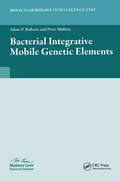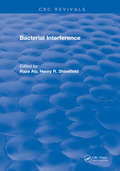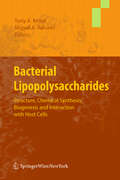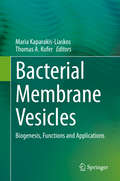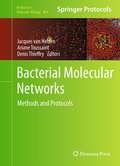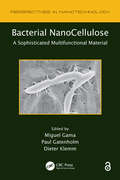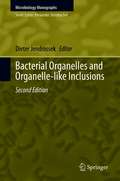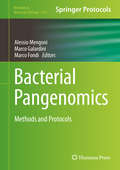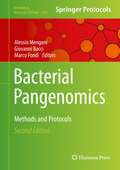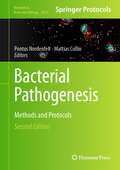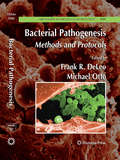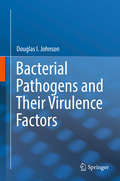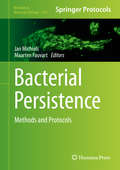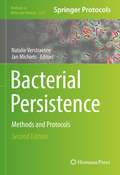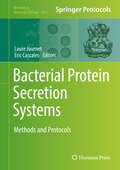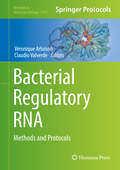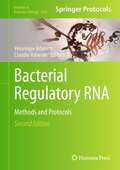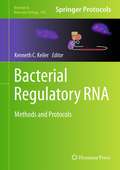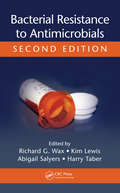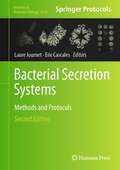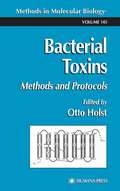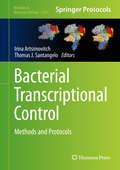- Table View
- List View
Bacterial Integrative Mobile Genetic Elements (Molecular Biology Intelligence Unit Ser.)
by Peter Mullany Adam P. RobertsAs our understanding of mobile genetic elements continues to grow we are gaining a deeper appreciation of their importance in shaping the bacterial genome and in the properties they confer to their bacterial hosts. These include, but are by no means limited to, resistance to antibiotics, and heavy metals, toxin production and increased virulence, production of antibiotics and the ability to utilize a diverse range of metabolic substrates. We are also gaining an understanding of diversity of these elements and their interactions with each other; a property which continually complicates any attempt to classify them. We are learning more about the molecular mechanisms by which they translocate to new genomic sites both within genomes and between different bacteria. This book provides a timely, state of the art update on the properties of an important selection of different bacterial integrative mobile genetic elements and the myriad of different ways in which they move and influence the biology of the host bacterium. The chapters are all written by authors who have undertaken pioneering work in their respective fields, making this book vital reading for all who are interested in the biology of bacteria and the mobile elements they carry.
Bacterial Interference
by Raza AlyThis text will provide a useful reference and guild to those who are interested in this important approach to microbial ecology. This book aims to provide the basis for future investigations which will in turn result in a practical biologic approach to the control and prevention of some serious infectious diseases.
Bacterial Lipopolysaccharides: Structure, Chemical Synthesis, Biogenesis and Interaction with Host Cells
by Miguel A. Valvano Yuriy A. KnirelThe bacterial lipopolysaccharide also known as endotoxin is exhaustively covered in the present work. Central emphasis is placed upon the fine chemical structure of the lipopolysaccharide and its significance for understanding their activity and function. In particular, the role it plays in the interaction of bacteria with other biological systems is examined. New aspects of their physicochemical biology are introduced and updates to the current knowledge concerning the lipopolysaccharide are provided. This important class of biomolecules has recently attracted the attention of many investigators, in particular for understanding its involvement in innate immunity, toll-like receptor recognition and intracellular signaling.
Bacterial Membrane Vesicles: Biogenesis, Functions and Applications
by Maria Kaparakis-Liaskos Thomas A. KuferThis book focuses on the multitude of functions bacterial membrane vesicles perform in bacterial ecology and pathogenesis as well as in emerging medical and biotechnological applications. Both Gram-negative and Gram-positive bacteria produce membrane-bound nanostructures, known as membrane vesicles, which have a range of functions that include serving as delivery vehicles, providing a means of communication over both spatial and temporal scales, and contributing to bacterial survival and evolution. Topics covered in this book range from the biogenesis and composition of bacterial membrane vesicles to their abundance and biological roles in microbial ecosystems, such as marine environments. In the individual chapters, the involvement of bacterial membrane vesicles in host-pathogen interactions, promoting virulence and in facilitating the establishment of infection is explained. In addition, current knowledge regarding membrane vesicles produced by commensal bacteria and their role in the maturation of the host immune system, as well as the therapeutic potential of bacterial membrane vesicles as delivery systems and innovative nanotechnology-based therapeutics are discussed. This work appeals to a wide readership of students and researchers interested in microbial ecology, mechanism underlying pathogenesis and new avenues in applied microbiology and nanotechnology.
Bacterial Metabolites in Sustainable Agroecosystem (Sustainable Development and Biodiversity #12)
by Dinesh K. MaheshwariThere has been a resurgence of interest in environmental friendly, sustainable and organic cultural practices that warrants high yield and quality in agricultural crops. To enhance sustainable agricultural production and alleviate food scarcity, spoor of majority of microorganisms, especially plant growth and health promoting bacteria of eminent characteristics that allow them for exploitation in agro-ecosystem. Plant growth promoting rhizobacteria are the soil bacteria inhabiting around/on the root surface and are directly or indirectly involved in promoting plant growth and development via production and secretion of various regulatory chemicals in the vicinity of rhizosphere. Among various beneficial bacteria mediated mechanisms include direct production of phytohormones and biosurfactants experiencing quest of research and concept up gradation that can built emerging paradigm (agriculture model). Research on bacteria-mediated phytohormones is crucially important, provides key understanding of the plant growth and development. Various genera including PGPR group of bacteria are potential source of plant growth regulators. Application of such organism allow plants to survive under abiotic and biotic stress conditions besides govern phytohormone mediated immune response and manage to regulate hormones. Such group of bacteria also produce another important metabolite i. e. biosurfacatants which are involved in many important functions to bacteria itself as we ll as for the plants and their ecosystem. Biosurfactants may alter nutrient availability, endogenous metabolites such as antibiotics production, root colonization imparting protection from phytopathogens besides eradicating soil contaminants and other pollutants. The role and activities of surfactants produced by bacteria are multifarious in nature. Thus, bacterial phytohormones and biosurfactants are identified as effector molecules in plant- microbe interactions, in pathogenesis and phyto-stimulation which can either be beneficial for the bacteria itself or for the crops. This book highlights current applications and research on bacterial hormones and surfactants to provide a timely overview. The chapters have been contributed by subject experts from around the world and include topics of varied importance which include phytohormones production by rhizospheric and endophytic bacteria, their role in rhizosphere competence, plant growth regulation, bioremediation, biosurfactants as antibiofilm agents and other aspects. This major new work represents a valuable source of information to all those scientists interested in microbial technology with respect to the microbial innovative products and applications towards sustainable agroecosystem.
Bacterial Molecular Networks: Methods and Protocols (Methods in Molecular Biology #804)
by Ariane Toussaint Denis Thieffry Jacques Van HeldenNetwork-based representations have become pervasive in most fields in biology. Bacterial Molecular Networks: Methods and Protocols provides authoritative descriptions of various experimental and computational methods enabling the characterization and analysis of molecular interaction networks, with a focus on bacteria. Divided into three convenient sections, this volume provides extensive coverage of various experimental and in silico approaches aiming at the characterization of network components, addresses the presentation of computational approaches to analyze the topology of molecular networks, and further introduces a variety of methods and tools enabling scientists to generate qualitative or quantitative dynamical models of molecular processes in bacteria. Written in the highly successful Methods in Molecular BiologyTM series format, chapters include introductions to their respective topics, lists of the necessary materials and reagents, step-by-step, readily reproducible protocols, and notes on troubleshooting and avoiding known pitfalls. Authoritative and accessible, Bacterial Molecular Networks: Methods and Protocols is intended primarily for post-graduate students and researchers working in the field of experimental and computational microbiology and provides a combination of up-to-date reviews along with detailed protocols written by the developers of bioinformatics resources, such as databases and software tools.
Bacterial NanoCellulose: A Sophisticated Multifunctional Material (Perspectives In Nanotechnology Ser. #9)
by Miguel GamaThe first book dedicated to the potential applications and unique properties of bacterial cellulose (BC), this seminal work covers the basic science, technology, and economic impact of this bulk chemical as well as the companies and patents that are driving the field. It reviews the biosynthesis and properties of BC, including genetics and characterization; discusses the advancing technology as it relates to product development, bioreactors, and production; and analyzes the economic impact of BC on a diverse range of industry applications, including materials and biomaterials, biological and polymer sciences, and electromechanical engineering.
Bacterial Organelles and Organelle-like Inclusions (Microbiology Monographs #34)
by Dieter JendrossekThe new series "Microbiology Monographs" begins with two volumes on intracellular components in prokaryotes. In this first volume, "Inclusions in Prokaryotes", the components, labeled inclusions, are defined as discrete bodies resulting from synthesis of a metabolic product. Research on the biosynthesis and reutilization of the accumulated materials is still in progress, and interest in the inclusions is growing. This comprehensive volume provides historical background and comprehensive reviews of eight well-known prokaryotic inclusions.
Bacterial Pangenomics: Methods and Protocols (Methods in Molecular Biology #1231)
by Marco Fondi Alessio Mengoni Marco GalardiniBacterial genomics is a mature research interdisciplinary field, which is approached by ecologists, geneticists, bacteriologists, molecular biologists and evolutionary biologists working in medical, industrial and basic science. Thanks to the large diffusion of bacterial genome analysis, Bacterial Pangenomics: Methods and Protocols is able to provide the most recent methodologies about the study of bacterial pangenomes by covering the three major areas: the experimental methods for approaching bacterial pangenomics, the bio informatic pipelines for analysis and annotation of sequence data and finally the methods for inferring functional and evolutionary features from the pangenome. Written in the successful Methods in Molecular Biology series format, chapters include introductions to their respective topics, lists of the necessary materials and reagents, step-by-step, readily reproducible protocols and notes on troubleshooting and avoiding known pitfalls. Authoritative and easily accessible, Bacterial Pangenomics: Methods and Protocols will serve as a field guide for both qualified bacterial genomics investigators who want to update their technical knowledge, for less experienced researchers who want to start working with bacterial genomics and pangenomics, as well as serving as a manual and supplemental textbook for graduate students of genomics and bioinformatics. "
Bacterial Pangenomics: Methods and Protocols (Methods in Molecular Biology #2242)
by Marco Fondi Alessio Mengoni Giovanni BacciThis completely revised edition explores novel discoveries in bacterial genomic research, with a focus on technical and computational improvements as well as methods used for bacterial pangenome analysis, which relies on microbiome studies and metagenomic data. Beginning with up-to-date sequencing methods, the book continues with sections covering methods for deep phylogenetic analysis, the role of metagenomic data in understanding the genomics of the many yet uncultured bacteria, progress in genome-to-phenome inference, as well as computational genomic tools. Written for the highly successful Methods in Molecular Biology series, chapters include the type of practical detail necessary for reproducible results in the lab. Authoritative and up-to-date, Bacterial Pangenomics: Methods and Protocols, Second Edition serves as an ideal guide for both highly qualified investigators in bacterial genomics and for less experienced researchers, including students and teachers, who could use a reference for approaching genomic analysis and genome data.
Bacterial Pathogenesis: Methods and Protocols (Methods in Molecular Biology #2674)
by Pontus Nordenfelt Mattias CollinThis detailed volume presents a diverse set of methodological approaches designed to improve our understanding of bacterial infections from a wide range of bacterial species. Beginning with biofilms and subcellular compartments, the book explores transcriptional analysis, methods for studying plasmid dynamics, and tools for phylogenetic analysis of bacterial genomes, as well as bacterial effector proteins interfering with host systems, host response analysis, and in vivo and in vitro infection models. Written for the highly successful Methods in Molecular Biology series, chapters include introductions to their respective topics, lists of the necessary materials and reagents, step-by-step and readily reproducible laboratory protocols, and tips on troubleshooting and avoiding known pitfalls. Authoritative and up-to-date, Bacterial Pathogenesis: Methods and Protocols, Second Edition is a vital resource for researchers in the area of infection biology, as well as but not limited to, those working in the fields of microbiology, immunology, structural biology, molecular biology, genetics, imaging, and computational study.
Bacterial Pathogenesis: Methods and Protocols (Methods in Molecular Biology #431)
by Michael Otto Frank DeleoBacterial infections affect world health today as a leading cause of morbidity and mortality. This book presents in-depth methods and state-of-the-art protocols for investigating specific mechanisms of pathogenesis for a wide range of bacteria. Written by experts in the field, this invaluable collection includes protocols to study host-pathogen interactions, animal models of infection, and novel approaches to identifying therapeutic targets designed to control infections.
Bacterial Pathogens and Their Virulence Factors
by Douglas I. JohnsonBacterial Pathogens and their Virulence Factors contains a detailed description of 32 major bacterial pathogens that affect human health and their associated virulence determinants. Chapter 1 gives an overview of the different types and classes of general virulence factors involved in host cell adherence and invasion, dissemination within the host, host cell damage, and evasion of host defense systems, as well as mechanisms by which these virulence factors are regulated. Chapters 2 through 33 give concise descriptions of the disease states associated with the 32 bacterial genera and their major pathogenic species, along with an in-depth description of the individual virulence factors that have been found to be functionally involved in pathogenicity. A detailed bibliography derived from primary literature and review articles accompanies each of these chapters, allowing the reader to delve more deeply into individual pathogens and their virulence determinants. Chapter 34 discusses the exciting possibilities and initial successes of using detailed information on a pathogen's virulence toolkit to design new therapeutics aimed at specific virulence traits.
Bacterial Persistence: Methods and Protocols (Methods in Molecular Biology #1333)
by Jan Michiels Maarten FauvartThis volume presents a comprehensive collection of methods that have been instrumental to the current understanding of bacterial persisters. Chapters in the book cover topics ranging from general methods for measuring persister levels in Escherichia coli cultures, protocols for the determination of the persister subpopulation in Candida albicans, quantitative measurements of Type I and Type II persisters using ScanLag, to in vitro and in vivo models for the study of the intracellular activity of antibiotics. Written in the highly successful Methods in Molecular Biology series format, chapters include introductions to their respective topics, lists of the necessary materials and reagents, step-by-step, readily reproducible laboratory protocols, and tips on troubleshooting and avoiding known pitfalls. Authoritative and cutting-edge, Bacterial Persistence: Methods and Protocols brings together the most respected researchers in bacterial persistence whose studies will remain vital to understanding this field for many years to come.
Bacterial Persistence: Methods and Protocols (Methods in Molecular Biology #2357)
by Jan Michiels Natalie VerstraetenThis volume presents a collection of methods that have contributed to the current understanding of bacterial persisters. Chapters in the book detail general guidelines for measuring persister levels in bacterial cultures, strategies to enrich and resuscitate persister subpopulations, single-cell approaches for visualizing and characterizing persisters, omics techniques and cellular and animal models for studying persistence. Written in the highly successful Methods in Molecular Biology series format, chapters include introductions to their respective topics, lists of the necessary materials and reagents, step-by-step, readily reproducible laboratory protocols, and tips on troubleshooting and avoiding known pitfalls. Authoritative and cutting-edge, Bacterial Persistence: Methods and Protocols, Second Edition aims to be a useful practical guide to researchers to help further their study in this field.
Bacterial Physiology and Metabolism
by Geoffrey Michael Gadd Byung Hong KimRecent determination of genome sequences for a wide range of bacteria has made in-depth knowledge of prokaryotic metabolic function essential in order to give biochemical, physiological, and ecological meaning to the genomic information. Clearly describing the important metabolic processes that occur in prokaryotes under different conditions and in different environments, this advanced text provides an overview of the key cellular processes that determine bacterial roles in the environment, biotechnology, and human health. Prokaryotic structure is described as well as the means by which nutrients are transported into cells across membranes. Glucose metabolism through glycolysis and the TCA cycle are discussed, as well as other trophic variations found in prokaryotes, including the use of organic compounds, anaerobic fermentation, anaerobic respiratory processes, and photosynthesis. The regulation of metabolism through control of gene expression and control of the activity of enzymes is also covered, as well as survival mechanisms used under starvation conditions.
Bacterial Protein Secretion Systems: Methods And Protocols (Methods In Molecular Biology #1615)
by Laure Journet Eric CascalesThis volume details protocols that cover the broad arsenal of techniques used to study a secretion system from A to Z. Chapters focus on identifying and localizing the different subunits, defining interactions within subunits, monitoring conformational changes, purifying and imaging of large complexes, defining the assembly pathway by fluorescence microscopy and the role of energy during assembly and/or secretion, identifying secreted effectors as well as reporters to follow effector transport. Written in the highly successful Methods in Molecular Biology series format, chapters include introductions to their respective topics, lists of the necessary materials and reagents, step-by-step, readily reproducible laboratory protocols, and tips on troubleshooting and avoiding known pitfalls. Authoritative and cutting-edge, Bacterial Protein Secretion Systems: Methods and Protocol aims to provide techniques that are not restricted to the study of secretion systems but are also of specific interest for any researcher interested on multi-protein complexes of the bacterial cell envelope.
Bacterial Regulatory RNA: Methods And Protocols (Methods In Molecular Biology #1737)
by Véronique Arluison Claudio ValverdeThis volume details the most important methods used for studying prokaryotic non-coding RNAs and their protein accomplices. Chapters present methods in sections covering different aspects of the biology of that field: identification of ncRNAs, their differential expression, characterization of their structure, abundance, intracellular location and function, their interaction with RNA binding proteins, and plausible applications of ncRNA elements in the rapidly emerging field of synthetic biology. Written in the highly successful Methods in Molecular Biology series format, chapters include introductions to their respective topics, lists of the necessary materials and reagents, step-by-step, readily reproducible laboratory protocols, and tips on troubleshooting and avoiding known pitfalls. Authoritative and cutting-edge, Bacterial Regulatory RNA: Methods and Protocols serves as a guidebook for scientists working toward the development of new tools and procedures for the vital field of sRNA biology.
Bacterial Regulatory RNA: Methods and Protocols (Methods in Molecular Biology #2741)
by Véronique Arluison Claudio ValverdeThis second edition details new and updated methods used for studying prokaryotic non-coding RNAs and their protein accomplices. Chapters detail discovery of ncRNAs, characterization of their structure, functions, and their interactomes. Written in the highly successful Methods in Molecular Biology series format, chapters include introductions to their respective topics, lists of the necessary materials and reagents, step-by-step, readily reproducible laboratory protocols, and tips on troubleshooting and avoiding known pitfalls. Authoritative and cutting-edge, Bacterial Regulatory RNA: Methods and Protocols, Second Edition aims to ensure successful results in the further study of this vital field.
Bacterial Regulatory RNA: Methods and Protocols (Methods in Molecular Biology #905)
by Kenneth C. KeilerThe discovery of wide-spread RNA-based regulation in bacteria has led to new evaluations of the importance of bacterial regulatory RNA in every aspect of bacterial physiology. In Bacteria Regulatory RNA: Methods and Protocols, expert researchers in the field detail many of the methods which are now commonly used to study bacterial regulatory RNA. These include methods and techniques to identify regulatory RNAs, characterizing the function and expression of regulatory RNAs in bacterial cells, RNA structure prediction, and interactions between regulatory RNAs and proteins. Written in the highly successful Methods in Molecular BiologyTM series format, chapters include introductions to their respective topics, lists of the necessary materials and reagents, step-by-step, readily reproducible laboratory protocols, and key tips on troubleshooting and avoiding known pitfalls. Authoritative and practical, Bacteria Regulatory RNA: Methods and Protocols seeks to aid scientists in the further study of bacterial regulatory RNA.
Bacterial Resistance to Antibiotics: From Molecules to Man
by Boyan B. Bonev Nicholas M. BrownAN AUTHORITATIVE SURVEY OF CURRENT RESEARCH INTO CLINICALLY USEFUL CONVENTIONAL AND NONCONVENTIONAL ANTIBIOTIC THERAPEUTICS Pharmaceutically-active antibiotics revolutionized the treatment of infectious diseases, leading to decreased mortality and increased life expectancy. However, recent years have seen an alarming rise in the number and frequency of antibiotic-resistant "Superbugs." The Centers for Disease Control and Prevention (CDC) estimates that over two million antibiotic-resistant infections occur in the United States annually, resulting in approximately 23,000 deaths. Despite the danger to public health, a minimal number of new antibiotic drugs are currently in development or in clinical trials by major pharmaceutical companies. To prevent reverting back to the pre-antibiotic era—when diseases caused by parasites or infections were virtually untreatable and frequently resulted in death—new and innovative approaches are needed to combat the increasing resistance of pathogenic bacteria to antibiotics. Bacterial Resistance to Antibiotics – From Molecules to Man examines the current state and future direction of research into developing clinically-useful next-generation novel antibiotics. An internationally-recognized team of experts cover topics including glycopeptide antibiotic resistance, anti-tuberculosis agents, anti-virulence therapies, tetracyclines, the molecular and structural determinants of resistance, and more. Presents a multidisciplinary approach for the optimization of novel antibiotics for maximum potency, minimal toxicity, and appropriated degradability Highlights critical aspects that may relieve the problematic medical situation of antibiotic resistance Includes an overview of the genetic and molecular mechanisms of antibiotic resistance Addresses contemporary issues of global public health and longevity Includes full references, author remarks, and color illustrations, graphs, and charts Bacterial Resistance to Antibiotics – From Molecules to Man is a valuable source of up-to-date information for medical practitioners, researchers, academics, and professionals in public health, pharmaceuticals, microbiology, and related fields.
Bacterial Resistance to Antimicrobials
by Kim Lewis Richard G. Wax Abigail A. Salyers Harry TaberThe enormous genetic flexibility of bacteria jeopardizes the usefulness of currently available antibiotics, and requires new approaches to antibiotic discovery and development. Antimicrobial resistance can be acquired in a short time frame, both by genetic mutation and by direct transfer of resistance genes across genus and species boundaries. Unde
Bacterial Secretion Systems: Methods and Protocols (Methods in Molecular Biology #2715)
by Laure Journet Eric CascalesThis second edition details new and updated protocols that cover techniques used to study secretion systems. Chapters focus on identifying and localizing the different subunits, defining interactions within subunits, monitoring conformational changes, purifying and imaging of large complexes, defining the assembly pathway by fluorescence microscopy and the role of energy during assembly and/or secretion, identifying secreted effectors as well as using reporters to follow effector transport. Written in the highly successful Methods in Molecular Biology series format, chapters include introductions to their respective topics, lists of the necessary materials and reagents, step-by-step, readily reproducible laboratory protocols, and key tips on troubleshooting and avoiding known pitfalls. Authoritative and cutting-edge, Bacterial Secretion Systems: Methods and Protocols- Second Edition aims to be a useful and practical guide to new researchers and experts looking to expand their knowledge.
Bacterial Toxins: Methods and Protocols (Methods in Molecular Biology #145)
by Otto HolstExperienced researchers describe in step-by-step detail powerful methods for the investigation of bacterial exo- and endotoxins. These state-of-the-art techniques range from purification and detection methods to methods of conformational analysis, and include the use of phage antibody libraries and methods of structural and functional analyses of endotoxins. Each protocol is described by a scientist who has regularly used the method and optimized it to a high level of performance. Extensive notes deal with the difficulties that may arise when using the method and with the method's limitations and possible modification for other purposes. Cutting-edge and geared to producing successful experimental results, Bacterial Toxins: Methods and Protocols provides investigators with a first-rate collection of readily reproducible methods designed to help today's bacterial toxin investigators-both novice and expert-utilize a wide array of powerful research tools.
Bacterial Transcriptional Control: Methods and Protocols (Methods in Molecular Biology #1276)
by Irina Artsimovitch Thomas J. SantangeloThis volume is designed to be a resource of proven techniques and approaches for probing the activities of bacterial, eukaryotic, and archaeal RNA polymerases. This book features a collection of in vitro and in vivo technologies that will permit researchers to purify and probe the position and stability of RNA polymerase complexes at different points of the transcription cycle, analyze the various translocations and intermolecular movements associated with catalysis, define recruitment strategies, probe the roles of transcription factors in each stage of the cycle, highlight conserved and disparate fidelity mechanisms, analyze the resultant transcripts, and study coordination of the nascent mRNA synthesis by the RNA polymerase and mRNA translation by the ribosome. Written in the highly successful Methods of Molecular Biology series format, chapters include introductions to their respective topics, lists of the necessary materials and reagents, step-by-step, readily reproducible laboratory protocols, and key tips on troubles troubleshooting and avoiding known pitfalls. Practical and timely, Bacterial Transcriptional Controls: Methods and Protocols highlights the breadth and depth of techniques that are likely to continue shaping the transcription community in the future.
